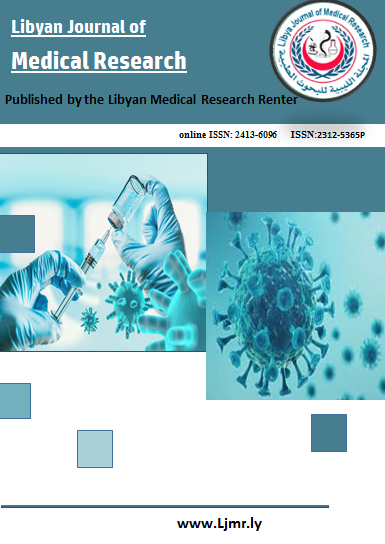Incessant ventricular tachycardia and Multi-organ failure after inferior STEMI due to Right coronary artery occlusion
DOI:
https://doi.org/10.54361/LJMR.19.1.04Keywords:
Inferior STEMI, Right coronary artery occlusion, Ventricular tachycardia, Cardiogenic shock, Multi-organ failure, Percutaneous coronary intervention (PCI)Abstract
Inferior wall myocardial infarction (STEMI) is commonly associated with hemodynamic instability and conduction disturbances; however, incessant ventricular tachycardia (VT) as a complication is rare. We report a case of a 66-year-old male with inferior STEMI due to right coronary artery (RCA) occlusion, who developed incessant monomorphic VT, cardiogenic shock, and subsequent multi-organ failure. Despite initial medical therapy, including dual antiplatelet therapy (DAPT), statins, and anticoagulation, the patient’s arrhythmia persisted, necessitating urgent percutaneous coronary intervention (PCI). Post-PCI, the patient experienced cardiogenic shock complicated by acute renal failure, ischemic hepatitis, disseminated intravascular coagulation (DIC), and required hemodialysis. Intensive critical care measures, including mechanical ventilation and renal replacement therapy, led to clinical improvement, and the patient was discharged after 18 days, hemodynamically stable with restored organ function.
Downloads
References
(1) Sanz Salvo, J., Arribas, F., López Gil, M., Dalmau, R., Garcíatejada, J., & Jiménez Valero, S. (2002). Incessant ventricular tachycardia as a manifestation of myocardial ischemia. Revista Española de Cardiología (English Edition), 55(2), 193-199. https://doi.org/10.1016/S0300-8932(02)75560-31
(2) Altay, H. (2019). Ventricular tachycardia and heart failure. In U. Lakshmanadoss (Ed.), Practical Applications of Electrocardiogram. IntechOpen2. https://doi.org/10.5772/intechopen.85256
(3) Zehender, M., Utzolino, S., Furtwangler, A., Kasper, W., Meinertz, T., & Just, H. (1991). Time course and interrelation of reperfusion-induced ST changes and ventricular arrhythmias in acute myocardial infarction. American Journal of Cardiology, 68(11), 1138-1142. https://doi.org/10.1016/0002-9149(91)90654-23
(4) Gressin, V., Louvard, Y., Pezzano, M., & Lardoux, H. (1992). Holter recording of ventricular arrhythmias during intravenous thrombolysis for acute myocardial infarction. American Journal of Cardiology, 69(3), 152-159. https://doi.org/10.1016/0002-9149(92)90139-23
(5) Six, A. J., Louwerenburg, J. H., Kingma, J. H., Robles de Medina, E. O., & van Hemel, N. M. (1991). Predictive value of ventricular arrhythmias for patency of infarct-related coronary artery after thrombolytic therapy. British Heart Journal, 66(2), 143-146. https://doi.org/10.1136/hrt.66.2.143
Downloads
Published
Issue
Section
License
Copyright (c) 2025 Ahmed Abdelrasol, Ruwaydah Abdulsalam Ali , Omar M Farag, Marwah M. Aeteewah, Ahmed safaidin Mikael (Author)

This work is licensed under a Creative Commons Attribution-NonCommercial-NoDerivatives 4.0 International License.
Open Access Policy
Libyan journal of medical Research (LJMR).is an open journal, therefore there are no fees required for downloading any publication from the journal website by authors, readers, and institution.
The journal applies the license of CC BY (a Creative Commons Attribution 4.0 International license). This license allows authors to keep ownership f the copyright of their papers. But this license permits any user to download , print out, extract, reuse, archive, and distribute the article, so long as appropriate credit is given to the authors and the source of the work.
The license ensures that the article will be available as widely as possible and that the article can be included in any scientific archive.
Editorial Policy
The publication of an article in a peer reviewed journal is an essential model for Libyan journal of medical Research (LJMR). It is necessary to agree upon standards of expected ethical behavior for all parties involved in the act of publishing: the author, the journal editorial, the peer reviewer and the publisher.
Any manuscript or substantial parts of it, submitted to the journal must not be under consideration by any other journal. In general, the manuscript should not have already been published in any journal or other citable form, although it may have been deposited on a preprint server. Authors are required to ensure that no material submitted as part of a manuscript infringes existing copyrights, or the rights of a third party.
Authorship Policy
The manuscript authorship should be limited to those who have made a significant contribution and intellectual input to the research submitted to the journal, including design, performance, interpretation of the reported study, and writing the manuscript. All those who have made significant contributions should be listed as co-authors.
Others who have participated in certain substantive aspects of the manuscript but without intellectual input should only be recognized in the acknowledgements section of the manuscript. Also, one of the authors should be selected as the corresponding author to communicate with the journal and approve the final version of the manuscript for publication in the LJMR.
Peer-review Policy
- All the manuscripts submitted to LJMR will be subjected to the double-blinded peer-review process;
- The manuscript will be reviewed by two suitable experts in the respective subject area.
- Reports of all the reviewers will be considered while deciding on acceptance/revision or rejection of a manuscript.
- Editor-In-Chief will make the final decision, based on the reviewer’s comments.
- Editor-In-Chief can ask one or more advisory board members for their suggestions upon a manuscript, before making the final decision.
- Associate editor and review editors provide administrative support to maintain the integrity of the peer-review process.
- In case, authors challenge the editor’s negative decision with suitable arguments, the manuscript can be sent to one more reviewer and the final decision will be made based upon his recommendations.














